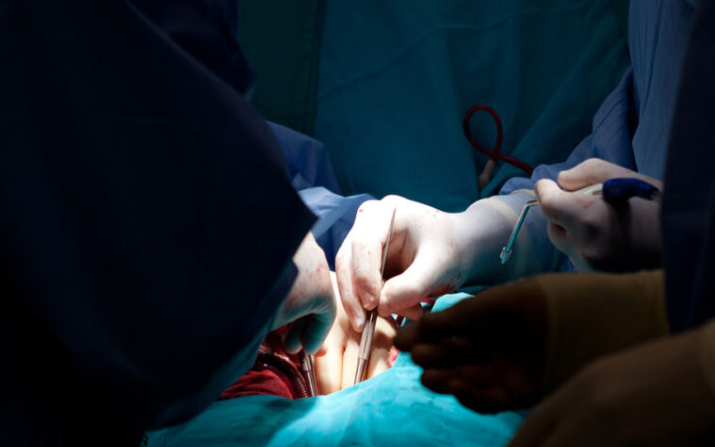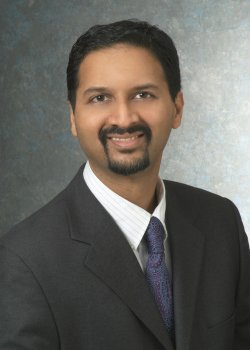Madabhushi lab working with researchers from Perelman School of Medicine at University of Pennsylvania, Cleveland Clinic and Cedars-Sinai Medical Center to begin training computers to glean from pathology images which patients will accept, reject heart transplant
The team of biomedical researchers at the Center for Computational Imaging and Personalized Diagnostics (CCIPD) has tackled various aspects of lung cancer, breast cancer, colon cancer and more since the center was launched at Case Western Reserve University in 2012 by bioengineering pioneer Anant Madabhushi.
Now, Madabhushi’s lab and partners in the Perelman School of Medicine at the University of Pennsylvania (Penn) and Cleveland Clinic, using Artificial Intelligence (AI)-driven precision medicine research, are applying those same techniques to look at which cardiac patients will be more likely to accept or reject a new heart.
Their team was recently awarded a four-year, $3.2 million National Institutes of Health (NIH) grant to pursue the project.
Cleveland Clinic, Penn, and Cedars-Sinai Medical Center will provide the data—digitized images of biopsies from patients who have already had transplants. Then, Madabhushi and Kenneth B. Margulies, MD, a professor of Cardiovascular Medicine at Penn, will apply the AI techniques to the data to see whether the initial biopsy images could have more accurately predicted which patients would accept or reject the new heart.
‘Applying the power of AI’
“Right now, the pathologists look at the biopsies and use their own rating scheme based on the features of the heart tissue,” said Madabhushi, the F. Alex Nason Professor II of Biomedical Engineering at Case Western Reserve. “What we’re doing, is applying the power of AI and computer vision to analyze the biopsy tissue images to quantitatively and reproducibly distinguish different cardiac rejection grades.”
Madabhushi and his team of researchers in the center, which has become a global leader in AI-driven precision medicine research, now numbers more than 60 post-doctoral students, graduate students and undergraduates.
In case after case, they have successfully taught the AI computers to find variations among thousands of digitized images of various cancers—anomalies mostly unseen by the naked eye.
Those variations in cellular arrangement and appearance, when interpreted by algorithms developed by the researchers, have helped scientists in previous studies more accurately predict which patients will respond better to chemotherapy or immunotherapy, for example, or to identify differences in how cancer cells appear among racial groups, among other findings.
However, unlike labs conducting other AI deep-learning experiments—referred to as “black box” approaches by Madabhushi because the process for arriving at the answer is essentially hidden in the algorithm alone—the CCIPD has also focused on more interpretable features, he said.
That will be true in this study as well, Madabhushi said.
“The spatial architecture of myocytes and lymphocytes (both types of cardiac cells) in heart biopsies has been long recognized by pathologists as a hallmark of transplant rejection,” Madabhushi said.
He added that his lab’s work will help “translate this human-based interpretation of cellular architecture into quantitative statistics of the spatial interplay and the relative proximity of myocytes and lymphocytes with respect to each other.”
Heart transplant rejection
Research shows that the most significant risks of a heart transplant is the patient’s body rejecting the donor heart, in part because the body’s “immune system may see the donor heart as a foreign object and try to reject it, which can damage the heart.”
Those rejections account for about 10% of all deaths within the first three years after transplantation, according to the National Center for Biotechnology Information, a division of the NIH.
So, knowing in advance the likelihood of rejection would make a big difference for pathologists and surgeons, Madabhushi said.
Additionally, the researchers plan to:
- Predict how patients will do over the long term, that is, not only whether they will accept or reject the donor heart, but whether they will remain healthy and for how long.
- Compare the relative performance of the computers against a human pathologist to accurately predict a transplanted heart’s acceptance or rejection. Previous CCIPD research has shown that the computers routinely defeat their human counterparts in diagnostic ability. Madabhushi has said that the research does not suggest machines will replace pathologists, but that they will work together and patients will benefit.
- Better define what Madabhushi called the “molecular underpinning” of the heart tissues. “We’re trying to understand the biology behind the features,” he said. “The machines only see the differences in spatial arrangement, but can’t tell us why. We want to also demystify the ‘black box’ of the AI, so that the human pathologist can have more confidence in what the computer is telling him that it has seen.”
Other collaborators include Drs. Michael D. Feldman, Priti Lal and Eliot Peyster from Penn; Dr. Wilson Tang from Cleveland Clinic and Dr. Jon Kobashigawa at Cedars-Sinai Medical Center.
The Case Western Reserve team also includes professor Pingfu Fu from the Department of Population and Quantitative Health Sciences; research assistant professor Andrew Janowczyk and Case School of Engineering graduate student Sara Arabyarmohammadi, both at the CCIPD.
Madabhushi is also chairing the Second Artificial Intelligence in Oncology (AIO) Symposium, Oct. 19-20.
For more information, contact Mike Scott at mike.scott@case.edu
(From The Daily, 10/5/20200


